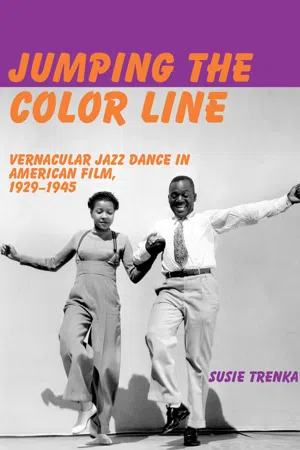
Jumping the Color Line
Vernacular Jazz Dance in American Film, 1929–1945
Susie Trenka
- 256 pages
- English
- PDF
- Disponible sur iOS et Android
Jumping the Color Line
Vernacular Jazz Dance in American Film, 1929–1945
Susie Trenka
À propos de ce livre
From the first synchronized sound films of the late 1920s through the end of World War II, African American music and dance styles were ubiquitous in films. Black performers, however, were marginalized, mostly limited to appearing in "specialty acts" and various types of short films, whereas stardom was reserved for Whites. Jumping the Color Line discusses vernacular jazz dance in film as a focal point of American race relations. Looking at intersections of race, gender, and class, the book examines how the racialized and gendered body in film performs, challenges, and negotiates identities and stereotypes. Arguing for the transformative and subversive potential of jazz dance performance onscreen, the six chapters address a variety of films and performers, including many that have received little attention to date. Topics include Hollywood's first Black female star (Nina Mae McKinney), male tap dance "class acts" in Black-cast short films of the early 1930s, the film career of Black tap soloist Jeni LeGon, the role of dance in the Soundies jukebox shorts of the 1940s, cinematic images of the Lindy hop, and a series of teen films from the early 1940s that appealed primarily to young White fans of swing culture. With a majority of examples taken from marginal film forms, such as shorts and B movies, the book highlights their role in disseminating alternative images of racial and gender identities as embodied by dancers – images that were at least partly at odds with those typically found in major Hollywood productions.
Foire aux questions
Informations
Table des matières
- Cover
- JUMPING THE COLOR LINE
- Title
- Copyright
- Contents
- Acknowledgments
- A Note on “Black” and “White”
- Introduction Jazz Dance on the Silver Screen: Race, Gender, Genre
- Chapter 1 Doomed Divas: Black Dancing Women in Early Sound Film
- Chapter 2 Kids and Class Acts: Male Dancers in Black-Cast Music Shorts
- Chapter 3 Potential Pioneer: The Film Career of Black Tap Dancer Jeni LeGon
- Chapter 4 Jumpin’ at the Jukebox, Dancin’ in the Street: Dance, Race, and Space in 1940s Soundies
- Chapter 5 Harlem to Hollywood: Whitey’s Lindy Hoppers and the Crossover Success of a Black Dance
- Chapter 6 “A Savage Exhibition”? Swing and White Youth Culture in B Movies
- Conclusion Dance History, the Swing Dance Revival, and Vintage Movies in the Digital Age
- Filmography
- Bibliography
- Index of Names and Titles